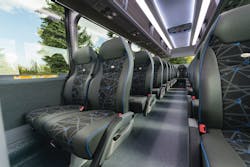By Brian A. Sullivan, Principal & Founder, Lost Art Communications
When it comes to bus procurement, we all know that the buy-side of the equation sets the expectations for the market, and the original equipment manufacturers (OEMs) and the component suppliers must react to those demands. To get a sense for the latest trends in procurement, however, it is the sell-side of the equation that has the finger on the pulse, so it is important for the industry to survey and assess what OEMs and suppliers are recognizing as trends when transit buyers are developing their specifications and soliciting bids and proposals.
For example, it is no secret that the demand (and even the mandate, in some cases) for zero-emission and electric-powered vehicles continues to grow, but the one-size-fits-all approach to standardizing fleets is fading and right-sizing for the needs of the operation is clearly the trend.
Procurement Process Status Quo; Price Remains Paramount
The first and most fundamental question when assessing purchasing trends is to analyze the procurement process itself. While the equipment and the technical features continue to change and evolve, the process of purchasing vehicles for transit agencies has not changed much, if at all. “Procurement of transit vehicles is not radically different today than it has been for last ten years,” said Patrick Scully, MCI Executive Vice President of Sales and Marketing. “But while the process remains the same, the newest frontier we are seeing is in the specifications for technology, especially electric buses.”
According to Todd Kangas, Director of Sales & Marketing – Advanced Products for component supplier EMP, “Price is still ‘king,’ which is why the development and definition of the equipment specifications are so important to our sales teams as they build relationships with the transit agencies.”
Right-Sizing with a Right-Sized Vehicle
One of the most impactful trends suppliers are seeing is the gradual move away from a homogenized fleet and toward a fleet mix that reflects what can best be described as right-sizing to fit the needs of the particular service.
“Increasingly, agencies are reconsidering their fleet mix. The reality for urban transit today is that it is no longer a one-size-fits-all approach, like the Southwest Airlines model,” said Michael Roschlau, a strategic advisor to Grande West Transportation Group and former Chief Executive Officer for the Canadian Urban Transit Association (CUTA). According to Roschlau, with slight declines in ridership across North America, agencies cannot justify using large 40-foot buses on some community and feeder routes.
Grande West has developed one solution for customers in its Vicinity community bus, a vehicle that in and of itself is right-sized. According to Grande West’s Vice President of Corporate Development John LaGourgue, the Vicinity bus is available in 27.5-, 30- and 35-foot models powered by clean diesel or CNG and is designed with affordability, accessibility and the environment in mind. “It represents a less costly alternative to a traditional 40-foot transit bus, burns less fuel and emits fewer emissions,” said LaGourgue. Recognizing the growing demand for electric vehicles, Grande West is developing a battery powered version to further expand the Vicinity’s value in the public transit marketplace.
Roschlau cautions, however, that these changes to transit fleets will need to occur over time. “Right-sizing is just a part of the 10-20-year transition toward a more dynamic and flexible fleet mix. It will not occur overnight.”
Entering the Zero-Emission Frontier, But What About the Infrastructure?
With the rising demand for electric vehicles, there is a commensurate demand for charging infrastructure, which represents a huge difference for the industry, according to Scully. “There is a learning curve on both sides of the procurement process,” said Scully. “For example, defining the range for an electric vehicle in the agency’s specification is much different than with a traditional diesel vehicle.”
So how is the supplier side of the transit industry addressing the infrastructure question?
MCI’s answer is to work alongside their customers to understand the specifications and learn together. “We invite customers to join us and our experts at our Vehicle Innovation Center where we address infrastructure concerns, as well as features like driver assistance systems and how they play into the vehicle specifications,” said Scully.
According to Roschlau, Grande West and the industry as a whole know that the age of the electric vehicle is coming. “The ‘Holy Grail’ is the optimal battery and energy storage solution. There are a lot of trials and errors going on regarding battery packs. The major advances are just not ideal yet, but the propulsion technology improvements are coming quickly, so I think we’ll get there,” said Roschlau.
Leveraging Technology to Extend Engine Life
Like the real estate industry’s “location, location, location” adage, from EMP’s perspective as a supplier, it’s all about “efficiency, efficiency, efficiency.” According to Kangas, “Transit customers are demanding more efficiency and extended vehicle life. So, we are working to make our components more efficient for the customers.”
EMP has developed patent-pending predictive and precision software systems that work together to promote extended engine and transmission life, minimize power needs and noise, and offer improved fuel economy. “If we can keep bus engines running at optimized temperatures we greatly increase safety and improve efficiency,” said Kangas.
Passenger Experience Enhancements Always a Challenge
“As suppliers, we need to help our customers appeal to each market segment they serve, whether commuter, community shuttle, urban transit, or mobility challenged,” said Roschlau. More than ever before, suppliers know they need to combine comfort, access, convenience, connectivity, and other passenger amenities – to truly offer mobility solutions for everyone.
As Roschlau summarizes, “It’s incumbent on us as suppliers to put the customer experience at the front of everything decision we make.”
